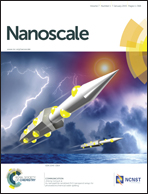Supported lipid bilayers as dynamic platforms for tethered particles
Abstract
Nanoparticle tethering to lipid bilayers enables the observation of hundreds of diffusing particles that are confined within a single field of view. A wide variety of materials ranging from plasmonic metals to soft matter can be stably tethered to the surface of a fluid bilayer by covalent or non-covalent means. The controlled environment of this experimental platform allows direct control over surface compositions and accurate tracking of nanoparticle interactions. This minireview will cover studies that use bilayer-tethered nanoparticles to investigate physical properties related to lipid mobility, biomolecule sensing, and surface interactions, as well as experiments to reversibly manipulate tethered nanoparticles by electric fields.


 Please wait while we load your content...
Please wait while we load your content...